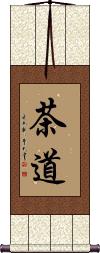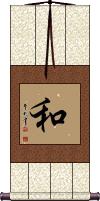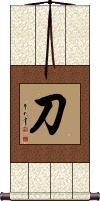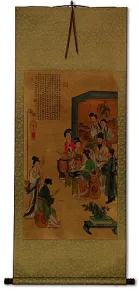Many custom options...
And formats...

Tea Ceremony in Chinese / Japanese...
Buy a Tea Ceremony calligraphy wall scroll here!
Personalize your custom “Tea Ceremony” project by clicking the button next to your favorite “Tea Ceremony” title below...
Elements of the Tea Ceremony
Wa Kei Sei Jaku
和, 敬, 清, 寂 or Wa, Kei, Sei, Jaku are the principles of the way of tea or 茶道.
The meanings are:
Harmony 和 (wa).
Respect 敬 (kei).
Purity 清 (sei).
Tranquility 寂 (jaku).
These principles or tenets were created by tea master Sen Rikyu (1522-1591). More about these ideas: Chanoyu
See Also: The Way of Tea
The Way of Tea
茶道 means The Way of Tea (literally, “tea way”) in Chinese and Japanese.
This may refer to a tea ceremony or a general lifestyle of tea preparation and drinking.
In Japanese, this can be pronounced sadō or chadō (seems that sadō refers more often to a tea ceremony, and chadō when it's the Way of Tea).
茶道 is also used in the Buddhist context with the same meaning as the Way of Tea.
Peace / Harmony
和 is the simplest form of peace and harmony.
和 can also be translated as the peaceful ideas of gentle, mild, kind, and calm. With a more harmonious context, it can be translated as union, together with, on good terms with, or on friendly terms.
Most people would just translate this character as peace and/or harmony. 和 is a very popular character in Asian cultures - you can even call it the “peace symbol” of Asia. In fact, this peace and harmony character was seen repeatedly during the opening ceremony of the 2008 Olympic Games in Beijing (a major theme of the games).
In old Chinese poems and literature, you might see this used as a kind of "and." As in two things summed together. As much as you could say, "the sun and moon," you could say "the sun in harmony with the moon."
See Also: Inner Peace | Patience | Simplicity
Katana
Japanese Samurai Sword
刀 is the Japanese Kanji for “sword.” This refers to the style of sword carried by warriors, samurai, and shogun of ancient Japan.
With the pacification of Japan, such swords are now only used for ceremony and decoration. The true art of sword-smithing is all but lost in Japan with new sword production dedicated to making inexpensive replicas for the tourist and foreign market.
For those of you that want to ask whether I can get you a real antique sword. Let me tell you that most real Asian swords were melted down after WWII in Japan, and during the Great Leap Forward in China. Any remaining swords are family heirlooms that nobody will part with.
Please carefully note that the Japanese kanji character shown above is only for a Japanese audience. In China, this character means “knife.” See our other entry for “sword” in Chinese.
Note: 刀 can mean knife, sword, or blade in Korean, depending on context.
See Also: Sword
This in-stock artwork might be what you are looking for, and ships right away...
Gallery Price: $200.00
Your Price: $79.88
Not the results for tea ceremony that you were looking for?
Below are some entries from our dictionary that may match your tea ceremony search...
| Characters If shown, 2nd row is Simp. Chinese |
Pronunciation Romanization |
Simple Dictionary Definition |
礼 see styles |
rei / re れい |
More info & calligraphy: Respect |
禮 礼 see styles |
lǐ li3 li rai らい |
More info & calligraphy: Respect(personal name) Rai Worship, offerings, rites; ritual, ceremonial, decorum, courtesy, etiquette. |
神幸 see styles |
shinkou; jinkou / shinko; jinko しんこう; じんこう |
More info & calligraphy: Miyuki / Shinkou / Shinko |
禮儀 礼仪 see styles |
lǐ yí li3 yi2 li i |
More info & calligraphy: Courtesy / Etiquette |
茶道 see styles |
chá dào cha2 dao4 ch`a tao cha tao sadou(p); chadou(ok) / sado(p); chado(ok) さどう(P); ちゃどう(ok) |
More info & calligraphy: The Way of Teatea ceremony; Way of Tea; sadō; (place-name) Chadō the way of tea |
和敬清寂 see styles |
wakeiseijaku / wakesejaku わけいせいじゃく |
More info & calligraphy: Elements of the Tea Ceremony |
儀 仪 see styles |
yí yi2 i gi ぎ |
apparatus; rites; appearance; present; ceremony (1) ceremony; (2) matter; affair; case; (suffix) (3) (used in letters, official notices, etc. after a person's name, personal pronoun, etc.) with regard to; as for; as concerns; (given name) Tadashi Manner, mode, style; ceremony, etiquette. |
儺 傩 see styles |
nuó nuo2 no na な |
to exorcise demons (archaism) (See 追儺) (ceremony of) driving out evil spirits |
典 see styles |
diǎn dian3 tien ten てん |
canon; law; standard work of scholarship; literary quotation or allusion; ceremony; to be in charge of; to mortgage or pawn (1) ceremony; celebration; (2) law code; (3) (abbreviation) (See 瑞典・スウェーデン) Sweden; (female given name) Michi Canon, rule; allusion; to take charge of; mortgage. |
匴 see styles |
suǎn suan3 suan |
bamboo utensil used for washing rice in ancient times; bamboo container for a hat used in the capping ceremony 冠禮|冠礼[guan4 li3] in ancient times |
卓 see styles |
zhuó zhuo2 cho taku(p); shoku たく(P); しょく |
outstanding (1) table; desk; (counter) (2) (たく only) counter for tables, desks, etc.; (3) (しょく only) {Buddh} offering table before an altar (sometimes used in tea ceremony); (4) (しょく only) (abbreviation) (See 卓香炉) tabletop incense burner; (given name) Masaru Lofty, tall erect. |
寮 see styles |
liáo liao2 liao ryou / ryo りょう |
hut; shack; small window; variant of 僚[liao2] (1) hostel; dormitory; (2) (archaism) (See 律令制) bureau (government department beneath a ministry under the ritsuryō system); (3) (archaism) (See 茶寮・1) tea-ceremony room; (4) (archaism) (See 別荘・1) villa; (surname, given name) Ryō A hut, study, monastery; fellow-student. |
式 see styles |
shì shi4 shih shiki しき |
type; form; pattern; style (n,n-suf) (1) way; style; fashion; method; system; form; type; (2) ceremony; rite; ritual; celebration; (3) wedding (ceremony); (4) equation; formula; expression; (5) (hist) (See 律令) enforcement regulations (of the ritsuryō legal codes); (given name) Shoku Style, shape, fashion, kind. |
拜 see styles |
bài bai4 pai hai はい |
to bow to; to pay one's respects; (bound form) to extend greetings (on a specific occasion); to make a courtesy call; (bound form) (of a monarch) to appoint sb to (a position) by performing a ceremony; to acknowledge sb as one's (master, godfather etc); (used before some verbs to indicate politeness) (personal name) Hai Pay respect (with the hands), worship: the forms of bowing and heeling are meticulously regulated. |
棗 枣 see styles |
zǎo zao3 tsao natsume; natsume なつめ; ナツメ |
(bound form) jujube; Chinese date (Zizyphus jujuba) (1) (kana only) jujube (Ziziphus jujuba); Chinese date; red date; (2) small tea caddy (tea ceremony); (surname, female given name) Natsume |
祭 see styles |
jì ji4 chi matsuri まつり |
to offer a sacrifice to (gods or ancestors); (in classical novels) to recite an incantation to activate a magic weapon; to wield (something magic); (bound form) ceremony; (Tw) (bound form) (celebratory) festival festival; feast; (surname, female given name) Matsuri Sacrifice, sacrificial. |
禊 see styles |
xì xi4 hsi misogi みそぎ |
semiannual ceremony of purification (noun/participle) {Shinto} purification ceremony (performed with water); ritual purification; ablutions; (female given name) Misogi |
翻 see styles |
fān fan1 fan hapaki はぱき |
to turn over; to flip over; to overturn; to rummage through; to translate; to decode; to double; to climb over or into; to cross (irregular okurigana usage) waste-water container (tea ceremony); (surname) Hapaki 繙 To translate, interpret. |
臘 腊 see styles |
là la4 la rou / ro ろう |
ancient practice of offering sacrifices to the gods in the 12th lunar month; the 12th lunar month; (bound form) (of meat, fish etc) cured in winter, esp. in the 12th lunar month (1) {Buddh} offering ceremony held on the third day of the dog after the winter solstice; (2) twelfth month of the lunisolar calendar; (3) (See 臈) year in the Buddhist order (after the completion of the first meditation retreat) Dried flesh; to sacrifice to the gods three days after the winter solstice; the end of the year; a year; a monastic year, i.e. the end of the annual summer retreat, also called 戒臘; 夏臘; 法臘. |
詰 诘 see styles |
jié jie2 chieh sakizume さきづめ |
(bound form) to question closely; to interrogate (n,suf) (1) stuffing; packing; (2) end (esp. the foot of a bridge); (3) lowest-ranking guest at tea ceremony; (4) tea master; (5) endgame (esp. in shogi or used figuratively); (6) (abbreviation) sweet eel sauce; (7) (archaism) middle-aged woman; (suffix noun) (8) appointment to a particular workplace; (9) using as the sole ground of judgement (judgment); (10) continuing; keep doing for period of time; (surname) Sakizume to reprove |
鐶 镮 see styles |
huán huan2 huan kan かん |
(ancient weight); metal ring (1) ring; link; (2) open spirals of heavy metal wire twisted into a kettle and used to lift it (tea ceremony); (given name) Tamaki A metal ring; a ring. |
お礼 see styles |
orei / ore おれい |
(1) (polite language) thanks; gratitude; (2) (polite language) manners; etiquette; (3) (polite language) bow; (4) (polite language) reward; gift; (5) (polite language) ceremony; ritual |
お茶 see styles |
ocha おちゃ |
(1) (polite language) tea (usu. green); (2) tea break (at work); (3) tea ceremony |
お詰 see styles |
otsume おつめ |
(1) lowest-ranking guest at tea ceremony; (2) tea master |
七事 see styles |
qī shì qi1 shi4 ch`i shih chi shih shichiji しちじ |
(archaic) the seven duties of a sovereign (abbreviation) (See 七事式・しちじしき) seven tea ceremony procedures of the Senke school |
交拜 see styles |
jiāo bài jiao1 bai4 chiao pai |
to bow to one another; to kneel and kowtow to one another; formal kowtow as part of traditional wedding ceremony |
仏名 see styles |
butsumyou / butsumyo ぶつみょう |
(1) Buddha's name; (2) (abbreviation) (See 仏名会) annual ceremony of reciting the names of the Buddhas |
仕服 see styles |
shifuku しふく |
silk pouch with drawstring for holding a tea caddy (tea ceremony) |
仕覆 see styles |
shifuku しふく |
silk pouch with drawstring for holding a tea caddy (tea ceremony) |
例式 see styles |
reishiki / reshiki れいしき |
regular ceremony; established form |
Click here for more tea ceremony results from our dictionary
The following table may be helpful for those studying Chinese or Japanese...
| Title | Characters | Romaji (Romanized Japanese) | Various forms of Romanized Chinese | |
| Elements of the Tea Ceremony | 和敬清寂 | wa kei sei jaku wakeiseijaku | ||
| The Way of Tea | 茶道 | cha dou / chadou / cha do | chá dào / cha2 dao4 / cha dao / chadao | ch`a tao / chatao / cha tao |
| Peace Harmony | 和 | wa | hé / he2 / he | ho |
| Katana | 刀 | katana | dāo / dao1 / dao | tao |
Successful Chinese Character and Japanese Kanji calligraphy searches within the last few hours...








